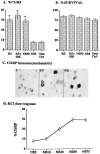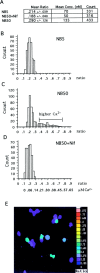Depolarization stimulates initial calcitonin gene-related peptide expression by embryonic sensory neurons in vitro
- PMID: 9801368
- PMCID: PMC6792901
- DOI: 10.1523/JNEUROSCI.18-22-09294.1998
Depolarization stimulates initial calcitonin gene-related peptide expression by embryonic sensory neurons in vitro
Abstract
The neuropeptide calcitonin gene-related peptide (CGRP) is expressed by one-third of adult rat lumbar dorsal root ganglion (DRG) neurons, many of which mediate pain sensation or cause vasodilation. The factors that regulate the developmental expression of CGRP are poorly understood. Embryonic DRG neurons initially lack CGRP. When these neurons were stimulated in culture by serum or persistent 50 mM KCl application, the same percentage of CGRP-immunoreactive (CGRP-IR) neurons developed in vitro as was seen in the adult DRG in vivo. The addition of the L-type calcium channel blockers, 5 microM nifedipine or 10 microM verapamil, dramatically decreased the proportion of CGRP-IR neurons that developed, although the N-type calcium channel blocker, 2.5 microM omega-conotoxin, was less effective. By contrast, the sodium channel blocker 1 microM tetrodotoxin had no effect on CGRP expression after depolarization. Fura-2 ratiometric imaging demonstrated that mean intracellular free calcium levels increased from 70 to 135 nM with chronic depolarization, and the addition of nifedipine inhibited that increase. Only a subpopulation of neurons had elevated calcium concentrations during chronic depolarization, and they were correlated with CGRP expression. Key signal transduction pathways were tested pharmacologically for their role in CGRP expression after depolarization; the addition of the CaM kinase inhibitor KN-62 reduced the proportion of CGRP-IR neurons to basal levels. By contrast, protein kinase A and protein kinase C were not implicated in the depolarization-induced CGRP increases. These data suggest that depolarization and the subsequent Ca2+-based signal transduction mechanisms play important roles in the de novo expression of CGRP by specific embryonic DRG neurons.
Figures





Similar articles
-
CCL2 and CXCL1 trigger calcitonin gene-related peptide release by exciting primary nociceptive neurons.J Neurosci Res. 2005 Oct 1;82(1):51-62. doi: 10.1002/jnr.20612. J Neurosci Res. 2005. PMID: 16047385
-
Localization of functional calcitonin gene-related peptide binding sites in a subpopulation of cultured dorsal root ganglion neurons.Neuroscience. 2002;110(1):131-45. doi: 10.1016/s0306-4522(01)00547-4. Neuroscience. 2002. PMID: 11882378
-
Expression of calcitonin gene-related peptide, substance P and protein kinase C in cultured dorsal root ganglion neurons following chronic exposure to mu, delta and kappa opiates.Neuroscience. 2002;115(2):441-53. doi: 10.1016/s0306-4522(02)00452-9. Neuroscience. 2002. PMID: 12421610
-
A role for L-type calcium channels in developmental regulation of transmitter phenotype in primary sensory neurons.J Neurosci. 1998 Feb 1;18(3):1047-55. doi: 10.1523/JNEUROSCI.18-03-01047.1998. J Neurosci. 1998. PMID: 9437025 Free PMC article.
-
Calcium and calcium-related proteins in endometrial cancer: opportunities for pharmacological intervention.Int J Biol Sci. 2022 Jan 1;18(3):1065-1078. doi: 10.7150/ijbs.68591. eCollection 2022. Int J Biol Sci. 2022. PMID: 35173539 Free PMC article. Review.
Cited by
-
Implantable Electrical Stimulation at Dorsal Root Ganglions Accelerates Osteoporotic Fracture Healing via Calcitonin Gene-Related Peptide.Adv Sci (Weinh). 2022 Jan;9(1):e2103005. doi: 10.1002/advs.202103005. Epub 2021 Oct 28. Adv Sci (Weinh). 2022. PMID: 34708571 Free PMC article.
-
The development of peripheral cold neural circuits based on TRPM8 expression.Neuroscience. 2010 Aug 25;169(2):828-42. doi: 10.1016/j.neuroscience.2010.05.039. Epub 2010 May 24. Neuroscience. 2010. PMID: 20580783 Free PMC article.
-
Physiological patterns of electrical stimulation can induce neuronal gene expression by activating N-type calcium channels.J Neurosci. 2001 Apr 15;21(8):2571-9. doi: 10.1523/JNEUROSCI.21-08-02571.2001. J Neurosci. 2001. PMID: 11306610 Free PMC article.
-
The melanocortin action is biased toward protection from weight loss in mice.Nat Commun. 2023 Apr 17;14(1):2200. doi: 10.1038/s41467-023-37912-z. Nat Commun. 2023. PMID: 37069175 Free PMC article.
-
Optogenetic activation of mechanical nociceptions to enhance implant osseointegration.Nat Commun. 2025 Mar 31;16(1):3093. doi: 10.1038/s41467-025-58336-x. Nat Commun. 2025. PMID: 40164597 Free PMC article.
References
-
- Adler EM, Fink JS. Calcium regulation of vasoactive intestinal polypeptide mRNA abundance in SH-SY5Y human neuroblastoma cells. J Neurochem. 1993;61:727–737. - PubMed
-
- Bading H, Ginty DD, Greenberg ME. Regulation of gene expression in hippocampal neurons by distinct calcium signaling pathways. Science. 1993;260:181–186. - PubMed
-
- Bito H, Deisseroth K, Tsien RW. CREB phosphorylation and dephosphorylation: a Ca stimulus duration-dependent switch for hippocampal gene expression. Cell. 1996;87:1203–1214. - PubMed
-
- Bito H, Deisseroth K, Tsien RW. Ca2+-dependent regulation in neuronal gene expression. Curr Opin Neurobiol. 1997;7:419–429. - PubMed
-
- Brain SD, Williams TJ, Tippins JR, Morris HR, MacIntyre I. Calcitonin gene-related peptide is a potent vasodilator. Nature. 1985;313:54–56. - PubMed
Publication types
MeSH terms
Substances
Grants and funding
LinkOut - more resources
Full Text Sources
Other Literature Sources
Research Materials
Miscellaneous
